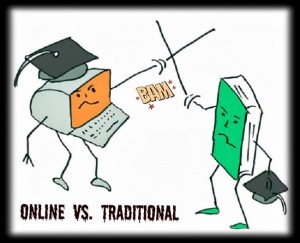How is learning presumed to occur within the context of Web 2.0?
In the context of Web 2.0, new kinds of online resources such as social networking sites, blogs, wikis, and virtual communities have allowed people with common interests to meet, share ideas, and collaborate in innovative ways. Web 2.0 is characterized especially by the change from static web pages to dynamic or user-generated content and the growth of social media.
Overall, Web 2.0 is a collaboration of the worlds information. The key is collaboration and people working together to be able to access the biggest source of information in the history of mankind. I found the importance of students who study in groups with my own personal experience. I agree fully that working in a group I am more engaged, better prepared, and can learn significantly more. Although, I have also found the importance of the people who are part of the group to be just important. Misinformation can be a challenge but group discussions can produce solutions. Overall, group collaboration has created millions of online communities. The phrase of – two minds are better than one – comes to thought. There are approximately 3.2 billion people, or almost half of the world’s population (total population 7.125 billion), who have access to the internet. In 2016, 78 percent of U.S. Americans had a social media profile. It is expected 2.5 billion people will social media users by 2018. With these statistics, it puts some perspective to how many people can access and share information with the rest of the online population.
What are the differences in the role of the learner and the facilitator as compared to ‘traditional’ learning environments? (Do you consider these roles and processes viable/valid given your philosophy of learning?)
A good point made by Minds on Fire, is that not enough traditional campuses can be built to meet the global demand for higher education. I also agree that the current methods of traditional teaching and learning will not suffice to prepare students for their lives in the twenty-first century. An online learning environment consists of active learning, discussion contribution, post reflection, and completing assigned tasks. The traditional learning environment consists of attending class, being respectful to participants, and completing course work by deadlines. The two are similar but still have differences. I see online learning environment as a place for more opportunity than a traditional learning environment. I also see online learning as more self-motivated than traditional learning.
The challenges of an online learning environment for an instructor include the instructor and student in separate locations, no face to face interaction, new technology to learn, new instructional design, and more demand for developing, preparing, and training delivery. Some of the challenges a student would have is time management, different methods of course learning materials, and technological capabilities.
To have a productive online learning environment an instructor should have clear objectives, maintain flexibility, encourage participation, have relevant material, and provide feedback. A student should have basic computer skills, have access to technology, keep an open mind, be self-motivated, be self-disciplined, and be willing to commit time to studies weekly.
Overall, there are main differences in the role of a learner and the facilitator compared to traditional learning environments. I consider the roles and processes to have clear pros and cons for each, and it depends on the students and facilitators personal preferences and abilities to which environment is suited for any given individual.
What implications do these shifts have for how we think about designing learning environments?
Implications to consider for designing and learning environment consists of the facilitator knowing the key characteristics of the students, knowing the goal of the course, knowing how students learn best, knowing how to implement the course knowledge, and knowing how to use technology to support the teachings. Valuable points to consider here is that it is ideal to identify the above components that need to be considered in teaching a course or program, and in particular that there are many components in addition to content or curriculum. As stated by Minds on Fire, “The traditional producers of knowledge (e.g., faculty) are also becoming consumers of the knowledge that their traditional consumers (e.g., grad students, firms in the region) produce.” With an online environment, the faculty has just as much of an opportunity to learn as the students do. With experience, and seeing what works and what fails, the faculty can work with the students to make the online learning environment as productive as possible.
References:
http://er.educause.edu/articles/2008/1/minds-on-fire-open-education-the-long-tail-and-learning-20
http://serendip.brynmawr.edu/sci_edu/seelybrown/
http://www.academia.edu/12230349/Online_vs_Traditional_Learning_Environments


I agree with you that there are many benefits to working in a group! Especially when the members come from diverse backgrounds and experiences. Students learn at different paces and have different strengths. The great thing about a study group is that the students can discuss and help one another gain a better understanding of the concept or look at the concept from a different point of view. John Seely Brown discussed one example of video taping lectures and sending them to groups of students. Students could then pause the videos periodically to discuss and share ideas. I think this practice was a great way to turn a lecture into a group discussion. This practice is used in classrooms more today where teachers use less lecture and more discovery and discussion based practices. You mentioned that the challenge with online classrooms is that students are in separate locations from the teacher and other students. What is nice is that there are so many ways to connect through the Internet, but I wonder if online discussions have the same impact as face to face interaction?
I agree with you that there are many benefits to working in a group! Especially when the members come from diverse backgrounds and experiences. Students learn at different paces and have different strengths. The great thing about a study group is that the students can discuss and help one another gain a better understanding of the concept or look at the concept from a different point of view. John Seely Brown discussed one example of video taping lectures and sending them to groups of students. Students could then pause the videos periodically to discuss and share ideas. I think this practice was a great way to turn a lecture into a group discussion. This practice is used in classrooms more today where teachers use less lecture and more discovery and discussion based practices. You mentioned that the challenge with online classrooms is that students are in separate locations from the teacher and other students. What is nice is that there are so many ways to connect through the Internet, but I wonder if online discussions have the same impact as face to face interaction?
Joseph — thank you for an insightful post. I chose specifically to comment on your post after I did on Sarah’s post as I feel I am just following up on what I thought about her post (https://sites.psu.edu/skstover/2016/09/03/week-2-reflection/comment-page-1/#comment-2).
The points that you discuss, especially those about the self-motivation and the different role and goals of the instructor bring it home for me in the context of my experience (and fear to an extent) with online education. As I was looking at graduate school options, my search did not even include online programs as my experience in the classroom in my undergraduate years had been very beneficial. Certain life events required me to not leave my job and to not lose the momentum I had gathered, I enrolled in an online program at the University College London, which was a terrible experience. The lack of engagement combined with the large valley in the instructor’s goals and my goals did not work for me and I ended up withdrawing from the program 8 weeks into it.
Not wanting to lose momentum, and armed with more information, I enrolled in the certificate program at LDT and the experience has been vastly different. A significant amount of resources have gone into the creation of these online courses and the will and motivation of the instructors is evident. This semester I am enrolled in my 3rd and 4th classes and I’m positive I will continue on to the masters program.
This long story attests to the fact that there are major differences between in the role of both the learner and the instructor/facilitator between the two teaching contexts. I felt like the “online” class at UCL was simply throwing the classroom materials up on the web and calling it online learning, which was not beneficial to my learning. PSU has allocated resources to the creation of a learning environment that is conducive to the gaining of knowledge for all of us students. How has your experience been with the online learning? Are self-motivation and discipline some of the challenges you face? Are there certain aspects of this method that you like more than the traditional methods?
Joseph, thank you for all of your thoughts! I am really eager to hear more of your thoughts as a non-education major. In one of the articles John Seeley Brown mentioned the concept of bricolage, taking something that exists and finding a new innovative and creative way to use it for a different purpose. You must have a unique view into existing technologies and how they may be used for the betterment of student learning. As a classroom teacher, I truly believe I will have a good deal to learn from you and your perspective which is so different from my own.
You mentioned the need for self-motivation in a non-traditional learner. I couldn’t agree more. In the last few years I have seen many students leave our traditional brick and mortar school and move into a cyber school environment, with a good number of them to return again citing their need to be more self-motivated and independent than they were currently ready to be in that moment in their lives. If the non-traditional classroom is truly the better fit for a student I am curious in how we can find methods to best support those students and help them find the self-motivation they need in order to be more successful.
I was really interested read about your views on the implications of designing learning environments in the context of Web 2.0. You mentioned needing to know your students and the goals of the course as two of the primary considerations. This resonates with me. I have be doing a good deal of reflecting into whether or not I truly know my students and how they learn the best. I am eager to learn varying perspectives of fellow classmates who are clearly more tech savvy than I am at this moment. I am hoping through all of your perspectives that I am able to get more inside of my students heads and better my instructional methods.
Joseph, I think the points you made about the differences in online and f2f learning/education are interesting from a design perspective but based on the texts we read, do you feel that the contrasts you drew are sufficient? Apart from the mechanics of the different learning spaces, what are the conceptual differences pointed to in the articles? Thanks!